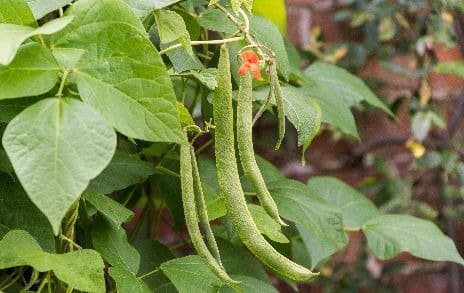Runner beans are one the most popular vegetable crops in Britain, and so easy to grow. They can be seen climbing up supports and wigwams across the country throughout summer. Their pretty flowers also make them an addition to the flower border.
The only hard work with runner beans is harvesting them regularly! If you stop picking, they stop producing. And picking the pods young stops them becoming stringy. Keep on top of gluts by freezing the surplus.
Soil: Rich. Dislikes acid
Position: Sunny, partial shade
Location: Outdoors, container
How to sow runner beans

Prepare the soil well in autumn – here is a guide.
Two weeks before sowing, rake the seed bed and add general purpose fertiliser.
Put in supports. For a traditional double row, push sturdy 2.4m bamboo canes into the ground, sloping towards each other and tie at the top to make a triangle shape.
The canes along each row should be 22cm apart and the rows should be 45cm apart. For wigwams, push four canes into the ground in a square and tie at the top to make a pyramid shape.
Sow a seed or plant a young runner bean 5cm deep at the base of each cane.
How to grow runner beans
Protect the seedlings from slugs and remove any weeds regularly.
Tie the young plants loosely to the canes as they grow. Once established, they will climb unaided.
If the weather turns dry during or after the flowering period, water copiously.
Apply a mulch in July to keep soil moist.
Once the plants rech the top of the supports, pinch out the growing tips.

Most people have no trouble with runner beans, but if your plants don’t set, try watering them well and misting foliage and flowers.
If your soil is neutral to acidic, try watering with hydrated lime.
How to harvest runner beans

Start to pick pods when they are more than approx. 15cm long.
Pick before the beans start to visibly swell inside the pods. Pick every couple of days and harvesting should continue for up to eight weeks.
Freeze gluts. Wash and chop the beans, then blanch for two minutes, drain and freeze.
Did you know?
Runner beans originated in South America and have been grown there for over 2000 years!
David’s Top Tip
Once you have harvested all the pods, dig the roots and stem bases back into the soil to add nitrogen for the next crop.

Hello, where can you purchase the runner bean netting or are you a dab hand at crochet ?